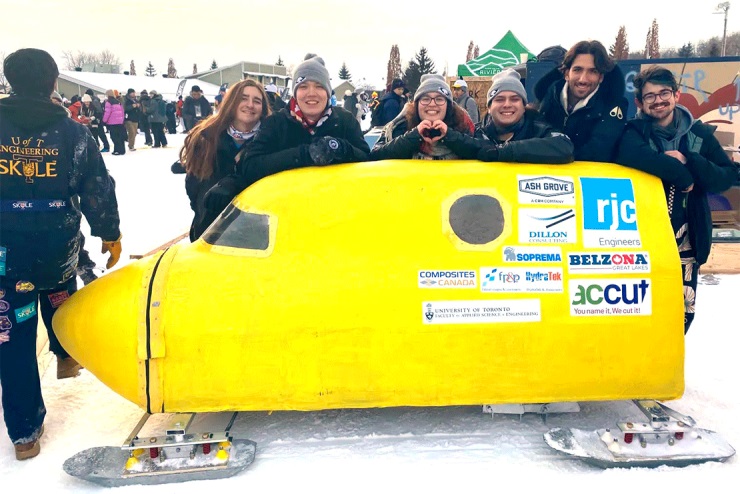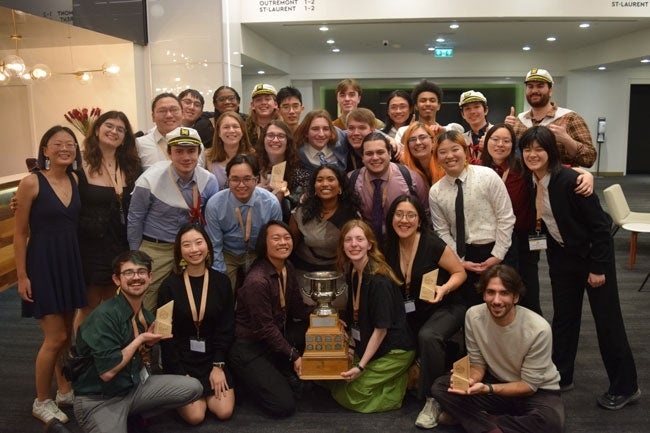A team of University of Toronto engineering students have careened their way into the top spot in an annual concrete toboggan race.
Their yellow, submarine-shaped vehicle - appropriately named Ringo - beat out nearly a dozen other challengers in the 2025 edition of the Great Northern Concrete Toboggan Race, which was recently held at the Groupe Plein Air Terrebonne ski resort near Montreal.

Members of the U of T Concrete Toboggan Design Team show off their yellow, submarine-shaped sled named "Ringo" (photo by Arshia Singh)
"I think we were all a bit surprised," says fourth-year mechanical engineering student Amélie Smithson, a co-captain of U of T's Concrete Toboggan Design Team.
"There was one other team that had a faster time than us, but the overall win is about accumulating the most points across all aspects of the competition. We were very happy to see the amount of work we put in pay off."

Members of U of T's Concrete Toboggan Design Team pose with their championship trophy (photo by Aidan Solala)
The annual race challenges teams from Canadian engineering schools to put their skills to the test by designing a fast and functional sled.
Any part of the sled that is normally in contact with the ground must be made of concrete and the vehicle must be equipped with both a functional braking and steering system. Five team members are required to ride the sled during the various races.
"I think a really valuable part of this competition is how novel it is," says fourth-year materials science and engineering student Tobin Zheng, the team's other co-captain.
"The unique set of requirements provides a really interesting engineering challenge."
Each team designs and builds a new sled from scratch every year. At U of T, the team consists of more than 100 students mostly, though not exclusively, from the Faculty of Applied Science & Engineering - but only about 30 attended the actual race.
The students have been working on Ringo for months. After creating models using computer-aided design (CAD) software throughout the spring and summer of 2024, they began pouring concrete parts and assembling the vehicle last fall.
Though the snow conditions in Toronto did not allow for a proper on-snow test before the competition, each part was tested individually to ensure it met safety requirements.
Among the criteria that the teams are judged on are the formulation of their concrete and the geometric profile used in the design.
"We earned second place for the geometric profile of our skis, which was designed to evenly distribute forces across the skis in order to reduce the likelihood of them cracking during the runs," says Smithson.
"Another unique aspect of Ringo is that she doesn't have a chassis. Instead, we integrated hard points into the structural members between the layers of carbon fibre, which helped us significantly reduce weight compared to previous years."
On race day, there are three events. The first is a time trial in which the goal is to attain the fastest speed - typically in the range of 25 to 30 kilometres per hour.
In the slalom event, the team must navigate through three gates on opposite sides of the track to test their sled's steering capabilities.
The final event is the King of the Hill competition in which teams go head-to-head in individual heats.
There are also points for team spirit, including the design of appropriate costumes - which Ringo and its supporters had in spades.
"I think that the spirit component is really valuable and something not a lot of other design competitions have," says Zheng.
"It fosters a sense of community and makes everyone enjoy the competition."
The team took second place in both the speed race and King of the Hill events, making their overall win as satisfying as it was surprising.
"As soon as they read out our name, everyone just exploded in excitement," Zheng says.
"We all rushed up on stage to receive the trophy, and it was a really wonderful moment."










